25 Plants That Grow in Water (With Pictures)
-
Pete Ortiz
- Last updated:
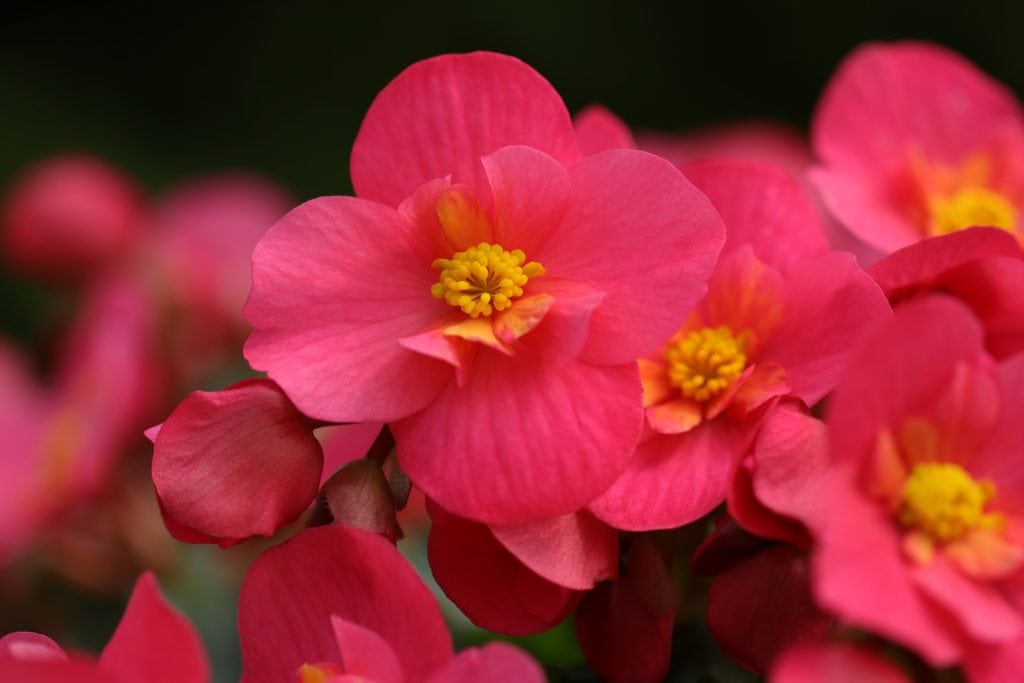
Soil is only one medium in which plants can grow and thrive. They are incredibly adaptable to various conditions. Being able to live in water makes evolutionary sense on several fronts. Many organisms disperse seeds along with environmental factors like wind. Often, they are left on bare ground or in small puddles of water. The ability to take advantage of these marginal conditions benefits plants.
It’s also an excellent way to start cuttings or seedlings. Plants are vulnerable during early growth. Giving them a chance to grow some roots provides them with an edge. They can obtain nutrients and moisture better, while the roots can help anchor them into the soil to help them weather windy conditions. Some plants can spend their lives in water. Others must feel the earth around their roots.

The Top 25 Plants That Grow in Water
1. Prayer Plant (Maranta leuconeura)
| Care | Moderate |
| Sun/Light | Partial shade/light |
| Placement | Start cuttings for pots |
The South American Prayer Plant is a striking plant with its beautifully colored foliage. It does best in warm conditions with indirect light, as its origin may suggest. It’s not the easiest to grow since it’s a tropical variety. It’s also a slow-growing plant that won’t get very tall. The species will do best in water as a means to start cuttings for transplanting into soil-filled pots.
- Attractive foliage
- Water-loving
- Not suitable for long-term growth
2. Begonia (Begonia spp)
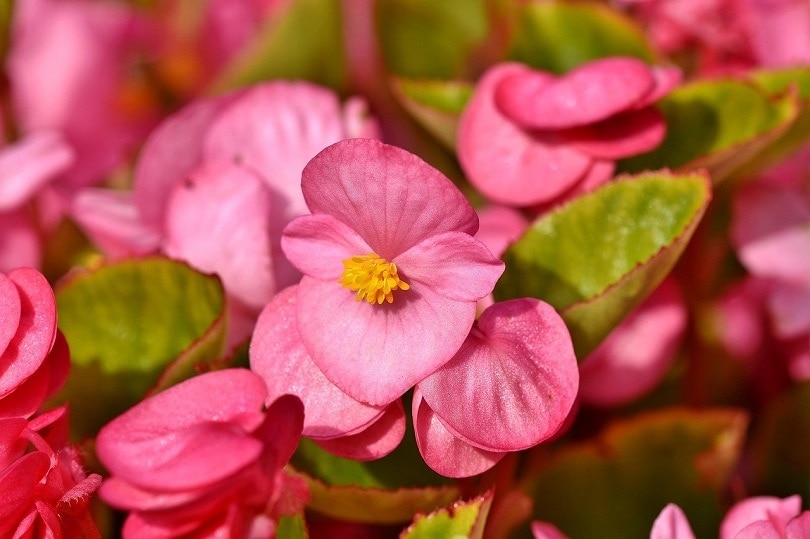
| Care | Easy |
| Sun/Light | Indirect sun/light |
| Placement | You can plant rooted cuttings in soil. |
The South American Begonia is worth the effort because of its pretty flowers. You’ll find many varieties, most of which do well in water. They are slow-growing plants that require time and patience. Regular water changes are vital to keeping it healthy. It’s tolerant of partial shade even during the winter months. However, avoid growing it indoors if you have a pet that eats houseplants.
- Beautiful flowers
- Many varieties
- Poisonous to dogs and cats
- Slow-growing
3. Pothos (Epipremnum aureum)
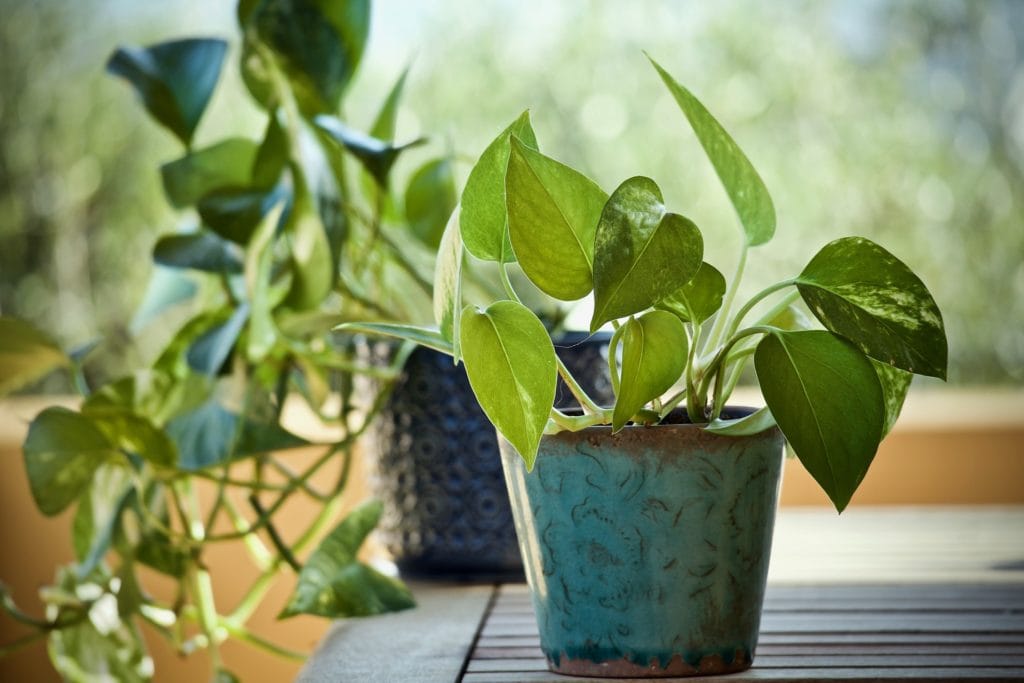
| Care | Easy |
| Sun/Light | Partial shade/light |
| Placement | Excellent for long-term growth |
You may see Pothos listed by its other more colorful moniker Devil’s Ivy. It’s a climbing plant with elongated leaves. It typically doesn’t produce flowers. Its beauty is in its foliage. It lives across Asia in the wild, hence, its preference for warmer temperatures. We think that Pothos is a natural for a tall vase with its long vines spilling over the edge.
You can also see the different types of pothos plants here.
- Easy to grow
- Beautiful display plant
- Poisonous to dogs and cats
- Sensitive to low-oxygen conditions
4. Chinese Evergreen (Aglaonema species)

| Care | Easy |
| Sun/Light | Partial shade/low light |
| Placement | Thrives in the long-term |
The Chinese evergreen is an excellent choice for beginners because of its tolerance for less-than-ideal conditions. Its white and green foliage is gorgeous and will reward you for your efforts. The only thing you should watch is the temperature. It’s a tropical plant that prefers it on the warm side. It’s also not keen on direct sunlight. This plant will fare best in low-lit places.
- Good starter variety
- Poisonous to dogs and cats
5. Lucky Bamboo (Dracaena sanderiana)
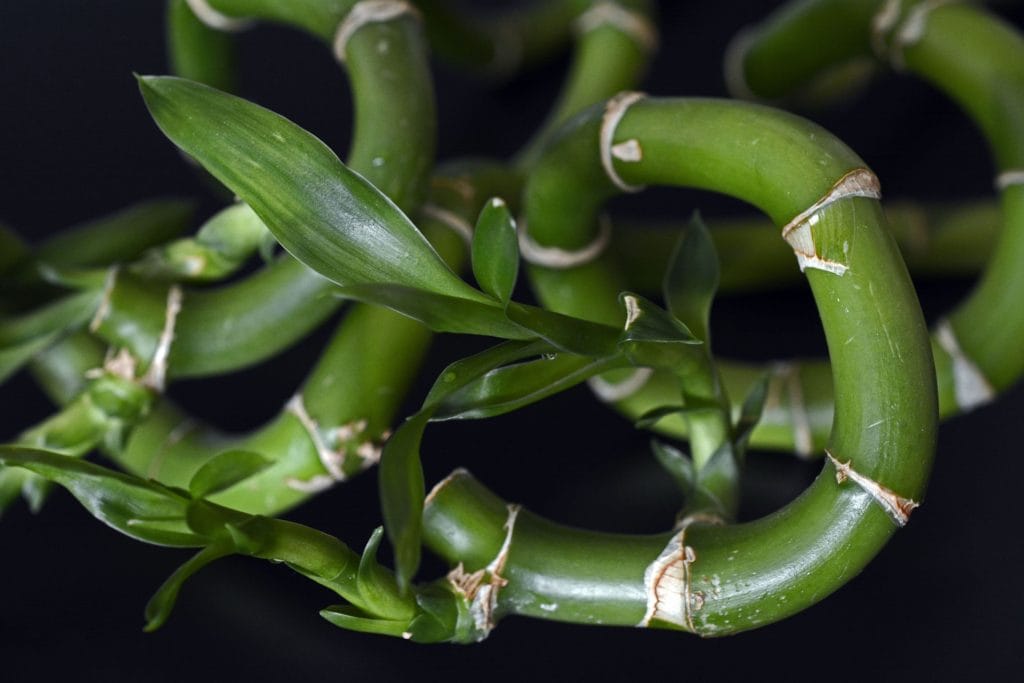
| Care | Easy |
| Sun/Light | Indirect light |
| Placement | Water or soil containers |
The name of the Lucky Bamboo is enough to make you want to give it a go. However, it’s not a true bamboo despite its moniker. Instead, it’s part of the same family as the asparagus. It’s a slow-growing plant that thrives best with weekly water changes. It likes it warm since it’s a West African species. Lucky Bamboo is an attractive plant that can fit in with any decor.
- Easy to grow
- Attractive plant
- Grows better in soil
- Mild toxicity for pets
6. Philodendron (Philodendron scandens)

| Care | Easy |
| Sun/Light | Partial shade/light |
| Placement | Long-term growth |
There’s so much to love about the Philodendron. It’s the plant that you can grow just about anywhere and even slack on its care. It will still thrive. Putting it in water is a no-brainer with its cascading vines. It’s a bummer that it’s poisonous to dogs and cats. This plant does well in low-lit places, such as bathrooms, although it prefers some light to look its best.
- Hardy
- Easy to grow
- Poisonous to dogs and cats
7. Impatiens (Impatiens walleriana)
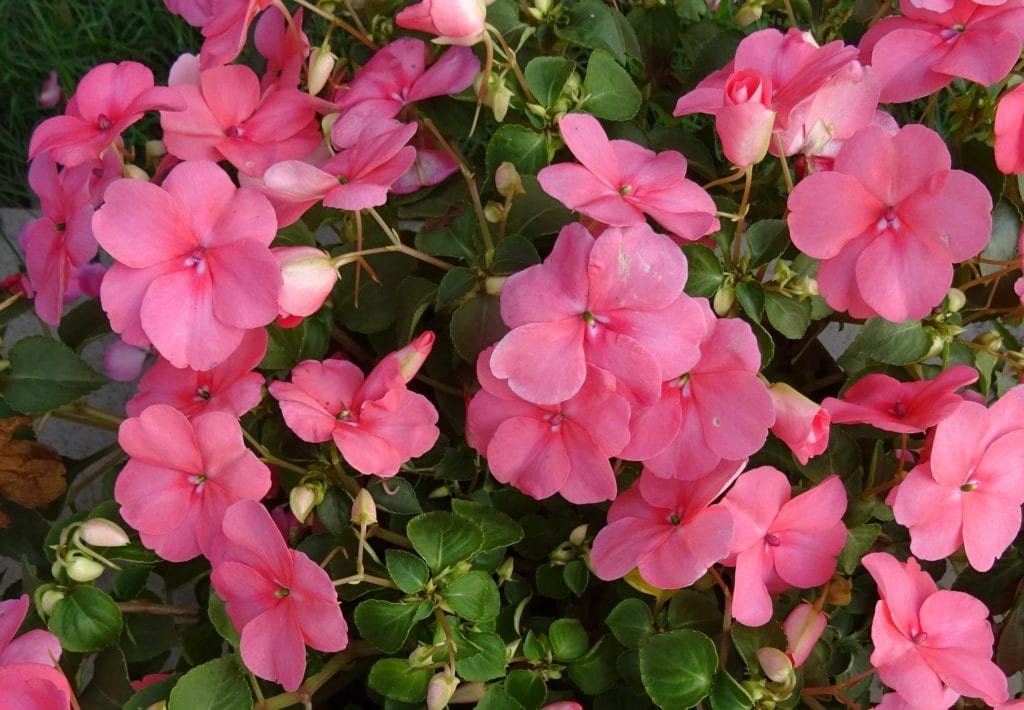
| Care | Easy |
| Sun/Light | Partial shade |
| Placement | Water and wetland conditions for outdoor planting |
Impatiens is such a pretty but understated plant. If it weren’t in your garden, it would live happily near your koi pond or along a stream. That makes it an excellent choice for one to grow in water. It ensures that the plant will get enough moisture. It’s a popular species with many varieties from which to choose. Keeping it in water will allow you to enjoy it year-round if you live outside of plant hardiness zone 10.
- Attractive flowers
- Tolerant of water plantings
- Frequent water changes necessary
8. Monstera (Monstera deliciosa)
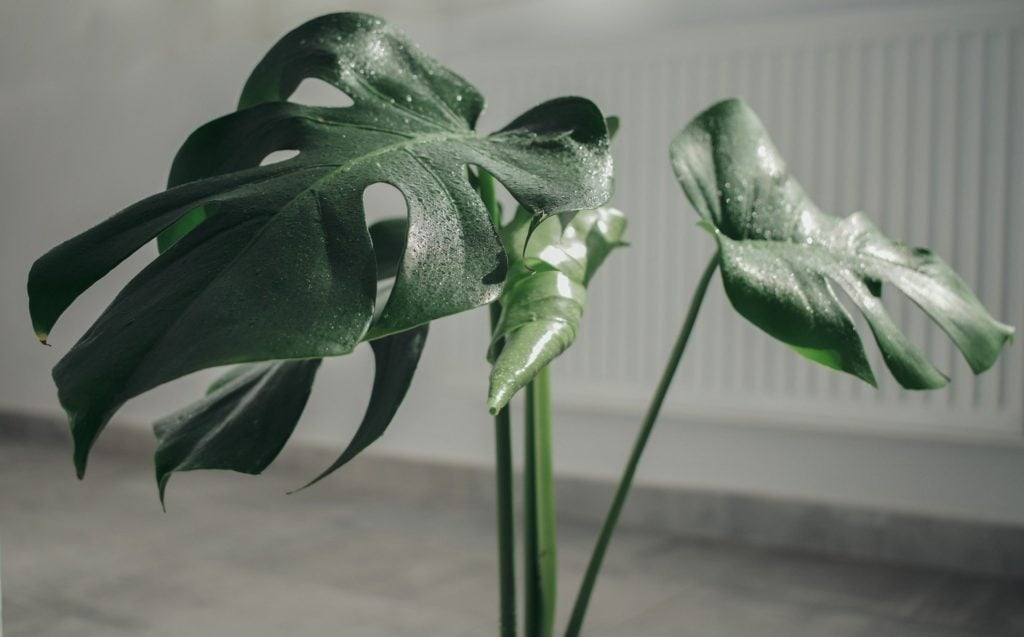
| Care | Easy |
| Sun/Light | Indirect sunlight |
| Placement | Water or soil plantings |
Monstera is a rainforest plant, making it an excellent choice for a watery environment. It may even grow in full shade in the wild. You may see it called the Swiss Cheese Plant because of its splitting leaves. The key is the amount of light it gets, with more causing more forks. It will also benefit from some liquid fertilizer a few times a year.
- Easy care
- Ideal for water setup
- Toxic to cats and dogs
9. Rubber Plant (Ficus elastica)
| Care | Easy |
| Sun/Light | Indirect sunlight |
| Placement | Water or soil plantings |
The Rubber Plant you grow in your home is a shadow of its wild counterpart that can reach a height of 100 feet or more. It is easy to care for and will grow relatively fast, requiring support as it gets taller. You can take cuttings off of it to control its growth. However, it has a sticky, white sap, making this task an outdoor job. It recovers well and will thrive in water or soil.
- Easy care
- Simple to propagate
- Thick, sticky sap
- Poisonous to dogs and cats
10. Chinese Money Plant (Pilea peperomioides)

| Care | Easy |
| Sun/Light | Bright indirect light |
| Placement | Small containers or pots |
You have to love a variety called the Chinese Money Plant. It gets its name from its unique leaves that look like coins. It also grows offshoots quickly, earning it its sharing moniker. It will do well in average household conditions if it doesn’t get too cold. The plant also prefers a lighted room to thrive. It’ll look best in a short, squat container.
- Easy to propagate
- Unique foliage
- Not tolerant of low-light conditions
11. Dumb Cane (Dieffenbachia spp)
| Care | Easy |
| Sun/Light | Bright, indirect light |
| Placement | Small yards and patios |
Dumb Cane is one of those plants that anyone with a so-called brown thumb should try. Growing it in water makes it even easier to raise. This plant can handle neglect and still thrive. It’ll make a beautiful centerpiece in a glass vase with pretty river stones in it. On the downside, it is highly toxic to pets, making it an unsuitable choice for some households.
- Hardy
- Attractive foliage
- Very poisonous to dogs and cats
12. Coleus (Plectranthus scutellarioides)

| Care | Moderately easy |
| Sun/Light | Partial to full shade |
| Placement | Water or soil |
Coleus is a striking plant with its red and green foliage. Luckily, it does well in water to give you more options for displaying it. It will pop against a light-colored wall in a sconce planter. It’s sensitive to temperature, which makes growing it inside in water a viable choice to enjoy this lovely, tropical plant. It requires rich soil that you can replicate with frequent feedings.
- Good-looking plant
- Loves moisture
- Poisonous to dogs and cats
13. Fiddle Leaf Fig (Ficus spp)
| Care | Moderate |
| Sun/Light | Bright, indirect sunlight |
| Placement | Water provides an excellent start |
The Western African Fiddle Leaf Fig thrives in water because it’s a suitable substitute for its tropical habitat. It’s relatively slow growing but can reach heights over 10 feet in the soil when it will reward you with flowers and fruits. Its leaves are large and the basis for its interesting name. Overall, it’s an easy-going plant that will make a welcome addition to your conservatory or plant room.
- Fares well in water and humidity
- Beautiful foliage
- Poisonous to dogs and cats
- See also: 16 Types of Ficus Trees (with Pictures)
14. English Ivy (Hedera helix)

| Care | Easy |
| Sun/Light | Partial to full light |
| Placement | Water containers or soil |
English Ivy is a gorgeous plant, whether you’re growing it in your yard or propagating it in water. You can snip off some cuttings and put them in a vase. The moisture is all they need to start forming roots. It looks stunning in a tall vase with its rich green foliage. Variegated varieties need more sun to keep their colors. However, it can do all right in indirect light, too.
- Easy to start
- Lovely form
- Not tolerant of low-light conditions for color
15. Aluminum Plant (Pilea cadierei)

| Care | Easy |
| Sun/Light | Partial shade/light |
| Placement | Thrives in water or soil |
The Aluminum Plant gets its name from the silver patches on its foliage. It’s easy to grow on many fronts. It is tolerant, although it prefers warmer temperatures. However, it also does best in partial shade instead of direct sunlight. It grows well in the right conditions, albeit sometimes too well. It can form a massive root ball that can even break glass containers.
- Relatively tolerant
- Easy to propagate
- Poisonous to dogs and cats
- Vigorous root growth
16. Spiderwort (Tradescantia zebrina)

| Care | Easy |
| Sun/Light | Partial shade |
| Placement | Shorter water-filled containers or soil |
Spiderwort is such a pretty plant, especially the purple varieties. It’s an excellent addition to the other ones on our round-up to add some color. It’s also one of those species that will grow babies to contribute to your collection. The plant will look best in a shorter container. You can cut off the offshoots and start additional cuttings easily.
- Easy to propagate
- Tolerant
- Some invasive varieties
- Mildly toxic to pets
17. Spider Plant (Chlorophytum comosum)

| Care | Easy |
| Sun/Light | Indirect sunlight |
| Placement | Water or soil |
The Spider Plant is probably about the easiest plant you can grow with the promise of lots of offspring to keep you well-supplied. Some may say it’s too prolific. It can outgrow a vase if not separated. Nevertheless, it’s one of the few species on our list that is non-toxic to pets, adding another point in its favor. It does well in water if you keep it clean.
- Easy care
- Prolific
- Needs replanting or separating often
18. Carrot Tops (Daucus carota subsp sativus)

| Care | Easy |
| Sun/Light | Indirect sunlight |
| Placement | Short-term growth |
Growing carrot tops is an excellent way to get more out of your fresh produce with some nutritious greens to add to your salad. All you need is the tops with a bit of the root still intact. It’ll do best with a substrate to hold it in place. Frequent water changes are necessary to prevent rot. It won’t grow another carrot, so it’s just a short-term thing for getting more bang out for your buck.
- Edible plant
- Quick-growing
- Susceptible to rot
19. Lemongrass (Cymbopogon citratus)

| Care | Easy |
| Sun/Light | Full to partial light |
| Placement | Water growing best |
Lemongrass is one of those plants you probably use a little occasionally. Undoubtedly, it’s hard to find when you need it. That makes growing it in your kitchen a smart idea. The plant makes it easy, too. All you need is a bit of the root and a clean container filled with water. You’ll need to put it in a taller one as it grows. Frequent water changes will keep it healthy. Keep it out of reach of your pets.
- Easy to grow
- Pleasant scent
- Frequent water changes
- Toxic to pets
20. Green Onions (Allium spp)
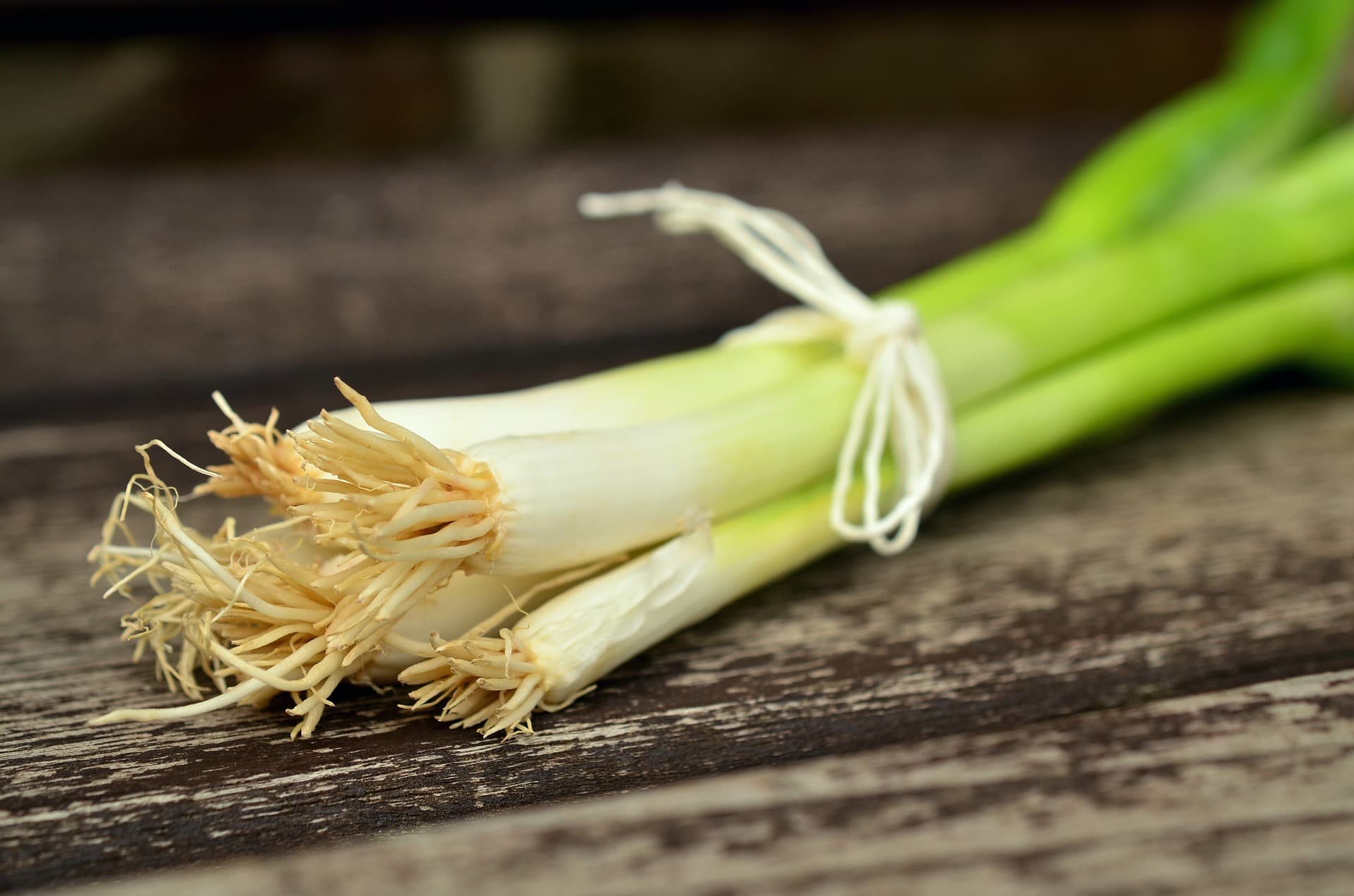
| Care | Easy |
| Sun/Light | Full to partial light |
| Placement | Water plant or transplant to a pot |
Growing Green Onions in water is one of the easiest things to do. All you need are the white bulbs from the produce you get at the store. They will sprout roots quickly. You’ll have another batch of greens in no time. The best thing about it is that you can keep yourself well supplied from just that one bunch you bought. It needs frequent water changes if you’re not going to plant it in a pot.
- Easy to grow
- Prolific producer
- Frequent water changes necessary
- Toxic to pets
21. Dwarf Hairgrass (Eleocharis arcicularis)
| Care | Moderate |
| Sun/Light | Medium to hight |
| Placement | Carpet-forming aquatic plant |
Dwarf Hairgrass is a fast-growing aquatic plant that will provide a lush carpet of vegetation for your pond or aquarium. It spreads by sending out runners like many species of this type. It’s one you’ll have to watch since it can easily fill up a space quickly. You can trim it or keep the fertilizer to a minimum to keep it under control. The plant can get up to 10 inches high.
- Quick growing
- Eay to find
- Sometimes aggressive
- Maintenance required
22. Arrowhead Plant (Syngonium podophyllum)

| Care | Easy to moderate |
| Sun/Light | Bright light |
| Placement | Containers best for large plants |
The growth pattern of the Arrowhead Plant is fascinating to watch as its leaves go from heart-shaped to its namesake. It can get quite high if you provide it with the necessary support and nutrition. This South American species likes it warm. Water is an excellent substrate since it can suffer in dry conditions. Regular water changes will provide enough oxygen and curb bacteria growth.
- Easy to grow
- Poisonous to dogs and cats
- Large growth
23. Dwarf Baby’s Tears (Hemianthus callitrichoides)
| Care | High maintenance |
| Sun/Light | Full sun or light |
| Placement | Carpet-forming aquatic plant |
Dwarf Baby’s Tears is an attractive plant with small leaves and fleshy stems. They can grow in a substrate in an aquarium or pond, forming a dense carpet. It’s an excellent way to provide cover for your aquarium fish. It’s a fussy plant that has specialized water chemistry needs. However, it doesn’t grow very tall and will cover an area quickly. Regular water changes are vital for keeping this plant healthy.
- Good shade coverage
- Smaller height
- CO2 imperative in aquariums
24. Dwarf Water Clover (Marsilea minuta)
| Care | Moderate |
| Sun/Light | Full sun or light |
| Placement | Carpet-forming aquatic plant |
Dwarf Water Clover is a good-looking plant that has two drawbacks for beginners. It needs extra maintenance to thrive. It also grows slowly, which can be discouraging for those wanting an attractive display quickly. This plant likes lots of light, which means you’ll have to watch for algae growth in the container. It’ll do best in a setup with fish or other aquatic organisms.
- Attractive plant
- Medium CO2 needs in aquariums
- Slow-growing
25. Duckweed (Lemna spp)
| Care | Easy |
| Sun/Light | Moderate |
| Placement | Floating aquarium or pond plant |
Duckweed is the only floating plant on our list. It gets its name from the fact that it’s a vital food source for waterfowl. It’s a small plant that has little rootlets hanging down into the water. It makes an interesting choice for a larger aquarium or pond, particularly with fish that have low-light needs. It can overwhelm a smaller area, requiring regular culling.
- Excellent food source
- Easy to grow
- Not suitable for small spaces
Aquatic Plant Growing Tips
Sanitation is a frequent care tip when it comes to growing plants in water. We suggest wrapping the roots in damp paper towels when you clean the container. A soapy dish soap solution will do the trick. Make sure the water is at room temperature to avoid shocking the plants.
A liquid fertilizer is also a must-have to supply the nutrients that the plants aren’t getting from the soil. Bear in mind that your use will affect their growth and whether you can keep them in the containers. You may find it necessary to prune them occasionally to keep them under control. Long-term care requires frequent maintenance to make sure they don’t outgrow their space.
You undoubtedly noticed that many plants on our round-up are toxic to pets. That makes putting them in hanging planters an excellent way for you to enjoy them without the risk of your dog or cat eating them.

Conclusion
Most plants take well to water, which gives you more ways to grow and display them in your home. Clean water is the best way to keep them healthy. Even if you’re not keeping them in water, starting them off this way is an excellent way to give cuttings a headstart before planting in a container or your garden. Besides, it’s hard to beat how something green can transform a room.
Featured Image Credit: Pixabay
Contents


